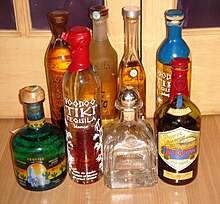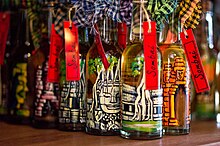
Vodka is a clear distilled alcoholic beverage. Different varieties originated in Poland, Russia, and Sweden. Vodka is composed mainly of water and ethanol but sometimes with traces of impurities and flavourings. Traditionally, it is made by distilling liquid from fermented cereal grains and potatoes since the latter was introduced in Europe in the 18th century. Some modern brands use corn, sugar cane, fruits, honey, and maple sap as the base.

Tsipouro is an un-aged brandy from Greece and in particular Thessaly, Epirus, Macedonia. Tsipouro is a strong distilled spirit containing 40–45% alcohol by volume and is produced from either the pomace or from the wine after the grapes and juice have been separated. Tsipouro is typically produced in two varieties: anise-flavored, which is the default, and pure, which contains no anise and is specifically labeled as 'without anise.' While tsipouro is usually not aged in barrels, barrel-aged versions are also available. It is similar to tsikoudia produced on the island of Crete, but unlike tsikoudia, which is single-distilled and contains no additional flavorings, tsipouro is typically double-distilled and frequently includes spices, primarily anise.
Rakija, rakia, rachiu, rakı or rakiya, is the collective term for fruit spirits popular in the Balkans. The alcohol content of rakia is normally 40% ABV, but home-produced rakia can be stronger.

Arak or araq is a distilled Levantine spirit of the anise drinks family. It is translucent and unsweetened.

Pomace spirit is a liquor distilled from pomace that is left over from winemaking, after the grapes are pressed. It is called marc in both English and French, but "grappa" in Italian and "bagaço" in Portuguese. In Spanish it is called orujo. Alcohol derived from pomace is also used as the traditional base spirit of other liquors, such as some anise-flavored spirits. Unlike wine brandy, most pomace brandies are neither aged nor coloured.

Aguardente (Portuguese), or aguardiente (Spanish), is a type of distilled alcoholic spirit that contains between 29% and 60% alcohol by volume (ABV). It is a somewhat generic term that can refer to liquors made from various foods. It originates from and is typically consumed on the Iberian Peninsula and in Iberian America.

Liquor is an alcoholic drink produced by the distillation of grains, fruits, vegetables, or sugar that have already gone through alcoholic fermentation. Other terms for liquor include: spirit, distilled beverage, booze, spirituous liquor or hard liquor. The distillation process concentrates the liquid to increase its alcohol by volume. As liquors contain significantly more alcohol (ethanol) than other alcoholic drinks, they are considered "harder." In North America, the term hard liquor is sometimes used to distinguish distilled alcoholic drinks from non-distilled ones, whereas the term spirits is more commonly used in the UK. Some examples of liquors include vodka, rum, gin, and tequila. Liquors are often aged in barrels, such as for the production of brandy and whiskey, or are infused with flavorings to form flavored liquors, such as absinthe.

Arrack is a distilled alcoholic drink typically produced in India, Sri Lanka and Southeast Asia, made from the fermented sap of coconut flowers or sugarcane, and also with grain or fruit depending upon the country of origin. It is sometimes spelled arak, or simply referred to as 'rack or 'rak. It is not to be confused with the anise-flavored distilled spirit called arak or araq. In many parts of India arrack is colloquially known as "desi daru".
Flavored liquors are liquors that have added flavoring and, in some cases, a small amount of added sugar. They are distinct from liqueurs in that liqueurs have a high sugar content and may also contain glycerine.

Tsikoudia is an alcoholic beverage, a fragrant, grape-based pomace brandy of Cretan origin that contains 40% to 65% alcohol by volume. Tsikoudia is made by distilling of pomace, what remains of grapes pressed in winemaking. In the eastern part of Crete, tsikoudia is often informally called raki, a name originating from the Ottoman 'raki', derived from the 17th-century Arabic 'arak', meaning 'distilled'.

Rum is a liquor made by fermenting and then distilling sugarcane molasses or sugarcane juice. The distillate, a clear liquid, is often aged in barrels of oak. While associated with the Caribbean due to its Barbadian origin, rum is nowadays produced in nearly every major sugar-producing region of the world, such as the Philippines, where Tanduay Distillers, the largest producer of rum worldwide, has its headquarters.

An alcoholic beverage is a drink that contains ethanol, a type of alcohol and is produced by fermentation of grains, fruits, or other sources of sugar. The consumption of alcoholic drinks, often referred to as "drinking", plays an important social role in many cultures. Alcoholic drinks are typically divided into three classes—beers, wines, and spirits—and typically their alcohol content is between 3% and 50%.
Oghi is an Armenian spirit distilled from fruits or berries. It is widely produced as moonshine from home-grown garden fruits all across Armenia, where it is served as a popular welcome drink to guests and is routinely drunk during meals. Arguably, Armenian oghi is not "vodka" at all and merely became thought of as such during the Soviet era in Armenia.

Amrut Distilleries Ltd is an Indian company that produces distilled beverages. It is best known for its eponymous Amrut brand of single malt whisky, which is the first single malt whisky to be made in India. The brand became famous after world famous whisky connoisseur Jim Murray gave it a rating of 82 out of 100 in 2005 and 2010. In 2010, Murray named Amrut Fusion single malt whisky as the third best in the world. John Hansell, editor of American magazine Whisky Advocate, wrote that "India's Amrut distillery changed the way many think of Indian whisky - that it was, in the past, just cheap Scotch whisky blended with who knows what and sold as Indian whisky. Amrut is making whisky, and it's very good".

Rakı or raki is an alcoholic beverage made of twice-distilled grape pomace and flavored with aniseed. It is the national drink of Turkey. It is popular in many Mediterranean countries and is often served as an apéritif or with seafood or meze. It is comparable to several other anise-flavored liqueurs such as pastis, ouzo, sambuca, arak and aguardiente. The alcoholic content of raki must be at least 40%. The largest producer of raki is Diageo; Yeni Rakı is the largest brand.























